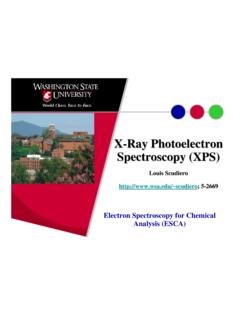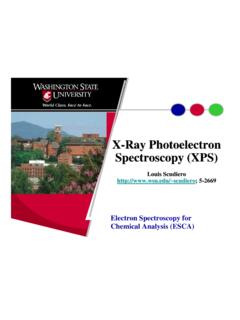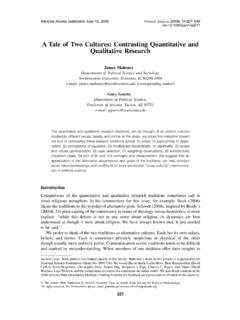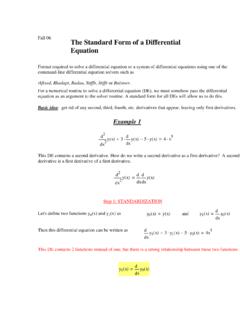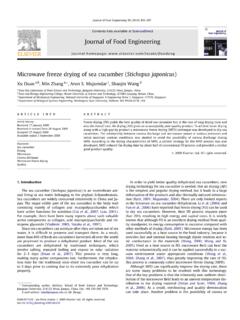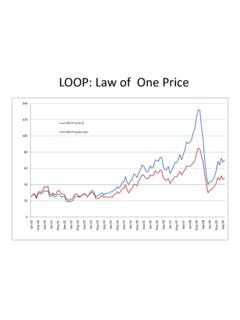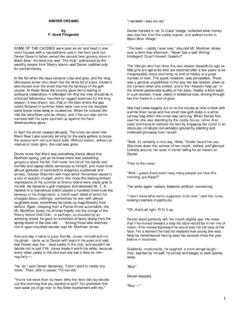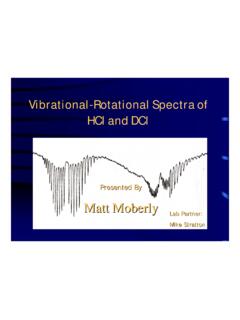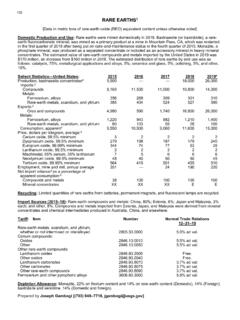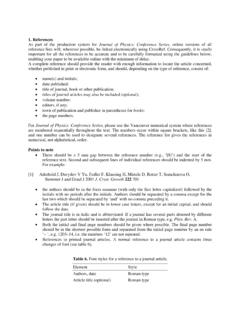Transcription of X-Ray Photoelectron Spectroscopy (XPS)-2
1 X-Ray Photoelectron Spectroscopy (XPS)-2. Louis Scudiero ~scudiero; 5-2669. Electron Spectroscopy for Chemical Analysis (ESCA). h . electron e The 3 step model: excitation of electron to the e surface (diffusion energy loss) Solid Vacuum into the vacuum 2. Diffusion energy loss 3. 1. Escape Excitation total Photoemission intensity for a normal incidence I ( ) . 4. At photon energy of 1254 eV (MgK X-Ray line), = and C = The intensity ratio is IH (90)/ IC (90) = x10-4. (Based of the Scofield's calculations of the cross-sections carried out relativistically using the single potential Hartree-Slater atomic model).
2 Lindau's calculations of the cross-section for isolated atoms (using the one- electron central-field frozen-core model and first order perturbation theory). total I ( ) . 4. For a photon energy of 1000 eV, = and C = The intensity ratio is IH (90)/ IC (90) = x10-3. Survey spectrum Loss peaks Six features seen in a typical XPS spectrum 1. Sharp peaks due to photoelectrons created within the first few atomic layers (elastically scattered). 2. Multiplet splitting (occurs when unfilled shells contain unpaired electrons).
3 3. A broad structure due to electrons from deeper in the solid which are ineslastically scattered (reduced KE) forms the background. 4. Satellites (shake-off and shake-up) are due to a sudden change in Coulombic potential as the photoejected electron passes through the valence band. 5. Plasmons which are created by collective excitations of the valence band Extrinsic Plasmon: excited as the energetic PE propagates through the solid after the photoelectric process. Intrinsic Plasmon: screening response of the solid to the sudden creation of the core hole in one of its atom The two kinds of Plasmon are indistinguishable.
4 6. Auger peaks produced by x-rays (transitions from L to K shell: O KLL or C KLL). Photoelectron Auger electron Sharp Peak (core level). F 1s peak O 1s peak Doublet and satellites peaks for Ni and Cr 2p 3. x 10. 45. 40 Ni 2p Cr 2p 35. CPS. 30. Sat Sat 25. 20. 885 880 875 870 865 860 855 850. Binding Energy (eV). Washington State University--Pullman, WA. Multiplet splitting occurs when there are unfilled shells containing unpaired electrons. For instance, transition metals with unfilled p and d orbitals and rare earths with unfilled f orbitals all show multiplet splitting.
5 Vacancy created by photoionization (unpaired electron left behind (after ionization)). couples with a unpaired electron in the originally incompletely filled shell and generates splitting of the orbital (p, d or f orbitals). Example: Fe2O3 has 5 unpaired electrons in the 3d shell as shown below. Following photoionization in the 3s shell, there are 2 possible final states. Schematic of Multiplet Splitting following photoionization in Fe 3+ and XPS spectrum Satellites arise when a core electron is removed by a photoionization.
6 There is a sudden change in the effective charge due to the loss of shielding electrons. (This perturbation induces a transition in which an electron from a bonding orbital can be transferred to an anti-bonding orbital simultaneously with core ionization). Two types of satellite are detected. Shake-up: The outgoing electron interacts with a valence electron and excites it (shakes it up) to a higher energy level. As a consequence the energy core electron is reduced and a satellite structure appears a few eV. below (KE scale) the core level position.
7 Shake-off: The valence electron is ejected from the ion completely (to the continuum). Appears as a broadening of the core level peak or contribute to the inelastic background. Shake-up satellites: distinct peaks a few eV below the main line. Shake-off satellites: broad feature at lower energy to main line. nlm (r , , ) = Ylm ( , ) Rn (r ). Plasmons This feature is specific to clean surfaces. 3. XPS Sp Si 2s The Photoelectron excites collective x 10. 35. Si 2s oscillations in the conduction band (free- electron gas), so called Plasmons.
8 (discrete 30. energy loss). 25. The plasmon (bulk) energy is 20. CPS. 4 ne2. h = h ( ) 1/ 2. plasmon 15. plasmon p m 10. n: e density, e: charge of e, m: mass of e electron. 5. 195 190 185 180 175 170 165 160 155 150 145. Binding Energy (eV). Surface plasmon: bulk plasmon / Washington State University--Pullman, WA. For Al, Mg, Na etc the energies are eV, eV and eV, respectively. Auger features Auger electron emission occurs also when x-rays impinge a sample. Auger electron is initiated by the creation of an ion with an inner shell vacancy.
9 Auger electrons are emitted 4. survey x 10. in the relaxation of the excited 80. Cu 2p Peaks ion. An electron from a higher 70. lying energy level fills the inner 60. shell vacancy with the simultaneous 50. emission of an Auger electron. 40. CPS. 30. It is a three-electron process. Cu 2s Cu Auger Peaks 20. Cu O Cu 3p 3 Distinct Auger Peaks are 10. 1s 3s seen in the data for Copper 1200 1000 800 600 400 200 0. Binding Energy (eV). Washington State University--Pullman, WA. Chemical shift arises in the initial state from the displacement of the electronic charge from the atom towards its ligands, reducing the electrostatic potential at the atom.
10 There is a final state shift due to the polarization of the ligand by the core on the central atom. Core electron BE in molecular systems exhibits chemical shifts which are simply related to various quantitative measures of covalency. Greater the electronegativity of the ligands, the greater the BE of the core electron of the ligated atom. Basic concept: The core electrons feel an alteration in Valence charge R. the chemical environment when a change in the Q. potential (charge distribution) of the valence shell occurs.
